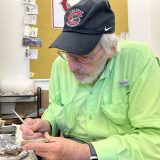One Chapman College Graduate and the Apollo Space Program Alumnus Cal (Collins) Roe '62
September 8, 2016

Alumnus Cal (Collins” Roe ’62
Cal (Collins) Roe grew up in Burbank, CA, where he graduated high school and studied engineering at a local community college. Following his then-girlfriend’s example, Roe enrolled in chemistry classes and then decided to join his girlfriend at Chapman College to study the chemistry of plastic materials – a decision that would set the pace of the rest of his career. Pursuing plastics seemed attractive as he was already working for an epoxy resin distributor mixing industrial chemicals and the late 1950’s saw a boom in the plastics industry. Once he graduated from Chapman College in 1962, Roe landed a chemical analysis position with General Precision where he stayed for the next three years.
His time with General Precision would eventually transition into a career with the Douglas Aircraft Company, a private contractor that was involved in the Apollo missions that sent a manned spacecraft to the Moon and back again. The Apollo program consisted of manned missions to the moon that occurred from 1963-1972. In order to bring these first astronauts to space, NASA used the Saturn V Rocket Series, which is where the SIVb that Roe helped on would come into play. While working as a junior lab engineer, Roe met senior engineers for the Apollo program who needed a “spark plug” to restart the Saturn IVb rocket engine. Roe made two versions using temperature resistant glass fiber reinforced silicone plastic. His ingenuity impressed the engineers and very shortly after, they offered Roe a position with the Apollo program in Huntington Beach, CA. There, he would work on what would become the SiVb rocket – the third stage for the Saturn V rocket and a major component for the Apollo program.
The third stage SIVb utilized liquid hydrogen (at -423 F) fuel, and liquid oxygen (at -297 F) as the oxidezer. Roe’s challenge was to minimize the boil-off of these cryogenic liquids while being structurally sound at these huge temperature extremes. “My primary involvement was the manufacturing and the bonding of polyurethane foam to the internal surfaces of the liquid hydrogen fuel tank,” he says. “Our materials research had determined that polyurethane foam could be One Chapman College Graduate and the Apollo Space Program repeatedly chilled to liquid hydrogen temperature (-423 F), and back to ambient temperature if glass threads were dispersed throughout the foam in all three directions (north-south, east-west, up-down).” After the glass thread weaving, foam expansion around the threads, curing, and machining, a 3D foam tile resulted. Thousands of 3D tile were bonded to the interior of the hydrogen tank under very specific conditions of time, temperature, pressure, and humidity conditions using an epoxy paste adhesive. To gain work-life of the epoxy, the entire hydrogen tank assembly (22 Ft in diameter and 58 feet long) was located in a barn sized building and first chilled to 35 to 40 degrees F during the 3D tile bonding. Then when all the 3D tile were bonded, the epoxy adhesive was then cured at 170 to 180 degrees F.
Small destructive test panels were made with the same materials and under the same conditions as the flight hardware to verify that the specific conditions of time, temperature, pressure, and humidity were within specification tolerances. The process would culminate when test coupons were cut from the test panel and tested in liquid nitrogen (-320 F). Occasionally, something would go wrong, leading Roe and the rest of the team to the conclusion that something in the bonding process was faulty. “We had a few frantic weeks at one point as all the coupons were failing when immersed in the liquid nitrogen. After reviewing all the data, testing the actual foam in the tank, analyzing the epoxy adhesive etc., and we could not find anything wrong,” he explains. “We were making plans to remove all the 3D foam or possibly scrap several tanks. Finally, we found that the chemical department had ‘improved’ the corrosion resistance of the anodic coating. The new improved anodic would not withstand the liquid nitrogen. The tank skins were anodized by the old method, and the coupons were anodized by the new method. We had our test panels anodized by the old way and the problem went away.”
When the Apollo project ended, Roe was involved with the Skylab project, where he and his colleagues converted the hydrogen fuel tank into living quarters in space. At the time, NASA was concerned about losing the nearly 400,000 workers that had helped put a man on the moon and the Skylab was a way to retain many of those employees. Scientifically this would lead to reopened discussions on the integrity of 3D polyurethane foam and astronaut safety. The polyurethane foam would burn almost explosively in the pure oxygen atmosphere One Chapman College Graduate and the Apollo Space Program being utilized and thus, a solution needed to be found and Roe’s team was involved. Testing indicated aluminum foil bonded to the internal foam surface would extinguish the flame in pure oxygen. The greatest exasperation in this project was to please the interior designers’ tastes for a less offensive color for the inner walls of Sky-Lab. Eventually they settled for a light yellow Teflon coating that had recently been developed by DuPont for use for non-stick household frying pans. The mock-up of Sky-Lab at the Smithsonian owes its pastel yellow walls to the work of Cal Roe in 1969.
“My job was to maintain the process specification. This is a document that provides detailed instruction on how to do something, and what materials to use. The NASA process requirements for the man-rated Apollo program were very specific. When a number, like temperature, is specified then there has to be a tolerance. There also must be test data at the tolerance limits to show that the properties of the materials are the same. Thus, there is a lot of material testing to support the process specification.
During a weeks work I would daily visit the production area and talk with the production personnel, where “I spent many hours inside a Saturn iVb hydrogen tank observing the workers to assure the actual production process being used was in accordance with the specifications we developed in the laboratory.” I’d review a new design drawing to assure the proper process specifications were specified on design drawings, I’d talk with NASA personnel to prove that a recent coupon failure was not a concern, I’d visit the laboratory to check on some testing or watch some tests, and I’d write a revision to the process specification.
This is where I learned the importance of the written word, and I really improved my writing skills over my college work.” The Skylab would eventually launch and orbit the earth from 1973 until 1979 when it would reenter the earth’s atmosphere but shortly thereafter, Roe’s work with the space program decreased. “I had no desire to get into supervision, because I enjoyed the hands-on work with the hardware. People problems were not for me. During my career I worked on many programs involving adhesive bonding including launching the GPS satellites. I retired in 1995, and now live in Oceanside CA with a lot of useless aerospace data fading from my 79 year old memory.”

